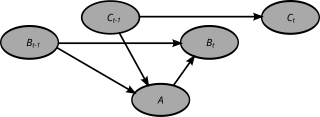Bayesian probability is an interpretation of the concept of probability, in which, instead of frequency or propensity of some phenomenon, probability is interpreted as reasonable expectation representing a state of knowledge or as quantification of a personal belief.
Statistics is a field of inquiry that studies the collection, analysis, interpretation, and presentation of data. It is applicable to a wide variety of academic disciplines, from the physical and social sciences to the humanities; it is also used and misused for making informed decisions in all areas of business and government.
Bayesian inference is a method of statistical inference in which Bayes' theorem is used to update the probability for a hypothesis as more evidence or information becomes available. Bayesian inference is an important technique in statistics, and especially in mathematical statistics. Bayesian updating is particularly important in the dynamic analysis of a sequence of data. Bayesian inference has found application in a wide range of activities, including science, engineering, philosophy, medicine, sport, and law. In the philosophy of decision theory, Bayesian inference is closely related to subjective probability, often called "Bayesian probability".
In statistics, point estimation involves the use of sample data to calculate a single value which is to serve as a "best guess" or "best estimate" of an unknown population parameter. More formally, it is the application of a point estimator to the data to obtain a point estimate.
In statistics, Markov chain Monte Carlo (MCMC) methods comprise a class of algorithms for sampling from a probability distribution. By constructing a Markov chain that has the desired distribution as its equilibrium distribution, one can obtain a sample of the desired distribution by recording states from the chain. The more steps that are included, the more closely the distribution of the sample matches the actual desired distribution. Various algorithms exist for constructing chains, including the Metropolis–Hastings algorithm.

Apache SpamAssassin is a computer program used for e-mail spam filtering. It uses a variety of spam-detection techniques, including DNS and fuzzy checksum techniques, Bayesian filtering, external programs, blacklists and online databases. It is released under the Apache License 2.0 and is a part of the Apache Foundation since 2004.
Bayesian statistics is a theory in the field of statistics based on the Bayesian interpretation of probability where probability expresses a degree of belief in an event. The degree of belief may be based on prior knowledge about the event, such as the results of previous experiments, or on personal beliefs about the event. This differs from a number of other interpretations of probability, such as the frequentist interpretation that views probability as the limit of the relative frequency of an event after many trials.

Naive Bayes classifiers are a popular statistical technique of e-mail filtering. They typically use bag of words features to identify spam e-mail, an approach commonly used in text classification.
Intelligent control is a class of control techniques that use various artificial intelligence computing approaches like neural networks, Bayesian probability, fuzzy logic, machine learning, reinforcement learning, evolutionary computation and genetic algorithms.

A Dynamic Bayesian Network (DBN) is a Bayesian network (BN) which relates variables to each other over adjacent time steps. This is often called a Two-Timeslice BN (2TBN) because it says that at any point in time T, the value of a variable can be calculated from the internal regressors and the immediate prior value. DBNs were developed by Paul Dagum in the early 1990s at Stanford University's Section on Medical Informatics. Dagum developed DBNs to unify and extend traditional linear state-space models such as Kalman filters, linear and normal forecasting models such as ARMA and simple dependency models such as hidden Markov models into a general probabilistic representation and inference mechanism for arbitrary nonlinear and non-normal time-dependent domains.
In Probability Theory, Statistics, and Machine Learning: Recursive Bayesian Estimation, also known as a Bayes Filter, is a general probabilistic approach for estimating an unknown probability density function (PDF) recursively over time using incoming measurements and a mathematical process model. The process relies heavily upon mathematical concepts and models that are theorized within a study of prior and posterior probabilities known as Bayesian Statistics.
Markovian discrimination in spam filtering is a method used in CRM114 and other spam filters to model the statistical behaviors of spam and nonspam more accurately than in simple Bayesian methods. A simple Bayesian model of written text contains only the dictionary of legal words and their relative probabilities. A Markovian model adds the relative transition probabilities that given one word, predict what the next word will be. It is based on the theory of Markov chains by Andrey Markov, hence the name. In essence, a Bayesian filter works on single words alone, while a Markovian filter works on phrases or entire sentences.
Bayesian poisoning is a technique used by e-mail spammers to attempt to degrade the effectiveness of spam filters that rely on Bayesian spam filtering. Bayesian filtering relies on Bayesian probability to determine whether an incoming mail is spam or is not spam. The spammer hopes that the addition of random words that are unlikely to appear in a spam message will cause the spam filter to believe the message to be legitimate—a statistical type II error.
Harold Joseph Kushner is an American applied mathematician and a Professor Emeritus of Applied Mathematics at Brown University. He is known for his work on the theory of stochastic stability, the theory of non-linear filtering, and for the development of numerical methods for stochastic control problems such as the Markov chain approximation method. He is commonly cited as the first person to study Bayesian optimization, based on work he published in 1964.
Statistical relational learning (SRL) is a subdiscipline of artificial intelligence and machine learning that is concerned with domain models that exhibit both uncertainty and complex, relational structure. Note that SRL is sometimes called Relational Machine Learning (RML) in the literature. Typically, the knowledge representation formalisms developed in SRL use first-order logic to describe relational properties of a domain in a general manner and draw upon probabilistic graphical models to model the uncertainty; some also build upon the methods of inductive logic programming. Significant contributions to the field have been made since the late 1990s.
Speckle is a granular interference that inherently exists in and degrades the quality of the active radar, synthetic aperture radar (SAR), medical ultrasound and optical coherence tomography images.

Gary Robinson is an American software engineer and mathematician and inventor notable for his mathematical algorithms to fight spam. In addition, he patented a method to use web browser cookies to track consumers across different web sites, allowing marketers to better match advertisements with consumers. The patent was bought by DoubleClick, and then DoubleClick was bought by Google. He is credited as being one of the first to use automated collaborative filtering technologies to turn word-of-mouth recommendations into useful data.



